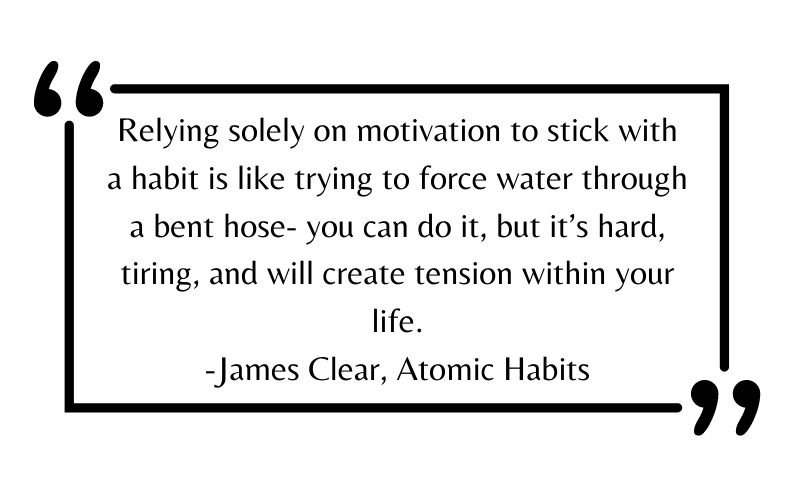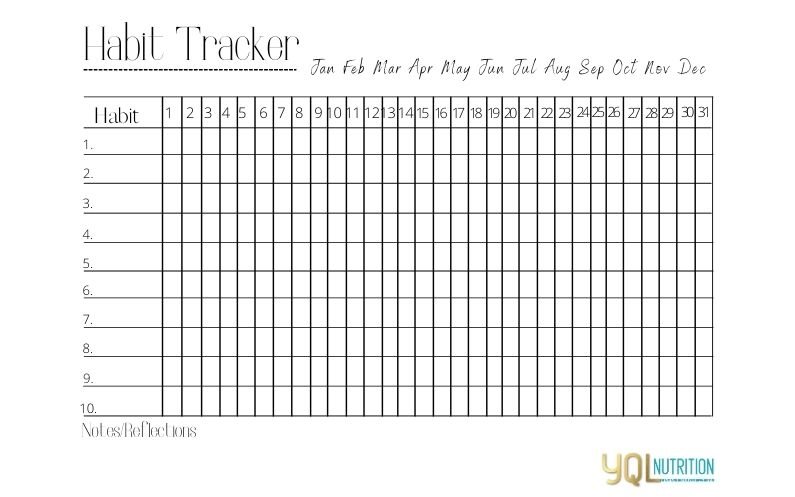The Power of Habits
As we introduced in our blog “The Foundation for Success Begins with a Healthy Lifestyle”, behaviour and lifestyle habits is the foundation of our pyramid; and consistency with your actions is the key to long-term sustained results.
Why is consistency so important?
Because consistent repetition of a behaviour will ultimately result in the formation of a habit. The beautiful thing about habits is we do them automatically- without a second thought. Checkout these research findings from a study conducted by Heroux et (2017) … highlighting how powerful habits can be for reaching your goals!
So, now that we know that habits are the key to success… how do we form them to benefit us?
Think slow, steady improvement! Try implementing habits gradually into your life rather than trying to do everything all at once! This ensures you are feeling confident with your current habit and helps prevent overwhelm from trying to do too much all at once.
Here are some key things that can help set you up for success. Did you know that approximately 45% of everyday behaviours are repeated in the same location(2)?
WHY IS THIS?!
Our daily lives, our environment, consistently exposes us to numerous cues, which then triggers a habit- both good and bad. For example, let’s talk about food, and what we “choose” to consume. “Choose” is in quotations because we really aren’t as in control as we think we are.
For example, have you ever had an exhausting day at work and then come home and reach for a snack? The first time an individual does this, they create a mental link between the context (arriving home) and their response (eating a snack) to that context . Each and every time you do this, this link strengthens until the point where getting home will prompt you to automatically reach for a snack… It is a habit(2).
Let’s broaden this example… you are stressed… you turn to food. You are tired or lonely… you turn to alcohol. You do these things without consciously understanding why you are acting this way, or being aware that you are making this choice. This is referred to as automaticity, or the ‘active ingredient’ of a habit(2). There is no reflective decision making involved once a habit has been created- you just DO.
However, once you are aware of your habits, and how they are either serving or limiting you, YOU have the power to change this!
So, how do we use the power of habits to serve us?! We begin to form new, healthier habits using these 4 laws
These four laws are based on the system we engage in when creating a habit, known as the habit loop. This involves a cue, a craving, a response, and a reward(1). To achieve the goals we want, we must focus on the SYSTEM that will get us there, which is habits and behaviours(1)!
First, Make it OBVIOUS- this is the CUE to initiate a behaviour/habit. So often we rely on our motivation, and even our self-discipline to move us forward to success; but what is often undervalued is how our ENVIRONMENT can set us up for success. Visual cues are the greatest catalyst for behaviour -> a small change in what you SEE can lead to a big shift in what you DO. Creating visual cues can draw your attention towards a desired habit.
If you want to remember to take your morning supplements, put them next to your coffee pot so you see them in the morning.
If you want to drink more water; fill your water bottles up so you have the visual reminder of how many you need to drink
If you want to work out when you get home from work, place your workout clothes somewhere you will see it right away when you come home.
This is referred to as Habit stacking, where you are using an already present habit or behaviour to CUE the next behaviour(1).
Remember YOU have the power to create these reminders in your environment… is there anywhere in your environment you could change to make things easier to achieve your habits?
Second, Make it ATTRACTIVE, or Spark a CRAVING.
Dopamine, that feel good brain chemical is released not only when you experience pleasure… but when you anticipate it(1)! So, let’s use our lovely brain chemistry to our advantage!
How?
TEMPTATION BUNDLING!
This is linking an action you want to do with an action you need to do(1). For example, say you know you need to walk more… but you really want to listen to your favourite audiobook. Using temptation bundling, you can only listen to your audiobook while you are going for a walk!
Community plays a huge role in this- we as humans crave to adopt habits that are praised and considered attractive by those around us. We have a strong desire to belong and are likely to imitate the habits of three social groups- the close (family/friends), the many (our social communities) and the powerful (those with status and prestige)(1).
If a behaviour can get us approval, respect, and praise, we find it attractive. For example, say you join a CrossFit gym that values community and holds you accountable to showing up and being physically active. You begin to respect members of this gym, and therefore want to be praised by these individuals as they watch you hit PR’s (personal records). All of a sudden getting off of the couch and going to workout gets a lot more ATTRACTIVE as we naturally crave acceptance.
Remember how we said you are in control of your environment, and the cues you fill it with? GUESS WHAT?!
You are also in control of how you frame your habits-you can choose to highlight their benefits, rather than their drawbacks. This instantly makes them more attractive!
Every time you think “I need to go workout” or “I need to be reading more”, reframe your thought process to “I get to work out” and “I get to enjoy this thought-provoking book”.
Struggling with meditation? WOW, every interruption gives you a chance to PRACTICE and return to your breath. These distractions are in fact, providing an opportunity for growth!
The key here is to reframe the associations you currently have with your habits, and make them more attractive to YOU.
Third, Make it EASY to do your desired RESPONSE to a cue/craving!
We as humans have been programmed to take the past of least resistance- we do not chase friction, but rather, ease and efficiency(1).
SO, WHAT IS THE SOLUTION?
Make your habits simple and easy, or, in relation to the reference, unkink the dang hose!
Start small, use each change in behaviour as a stepping stone to the next desired behaviour. For example, say you have a goal of running a marathon. Where do you start?
The first time you go for a run, you do not run a marathon. You start small, maybe 1 Km. You continue this until it becomes easy, and then try adding another. Now look, you are successfully running 2 km, and it feels easy! Time to add a 3rd km. And you continue on until you can run 10km, then 15…etc.
You do not start off by trying to run a marathon the first day, failing, and giving up.
It is EASIER to start off small, get your reps in, and then build on these behaviours instead of biting off more than you can chew and giving up.
When it comes to habits, repetition trumps perfection, or (get used to us saying this…) CONSISTENCY OVER PERFECTION. Start small, be consistent, and know that in a year from now, these small actions will compound into an incredibly sustainable lifestyle change!!!
Finally, make it SATISFYING by giving yourself a REWARD.
Let’s talk some basic psychology here… have you ever heard of positive or negative reinforcement? Well, this refers to the cardinal rule of behaviour change- it works on yourself, your kids, and even your pets.
What is REWARDED is REPEATED.
What is PUNISHED is AVOIDED.
Why do we scroll Instagram? Well, it sure feels validating when our last post gets a few ‘likes’.
Why do we crave cookies and cake? They taste so good… HELLO DOPAMINE!
BUT, We can also use this to impact us positively.
If you make your bed in the morning, you get to come home to a clean bed !
If you go for a walk after eating lunch, your digestion improves!
Part of being able to enjoy this reward comes with the accountability of hitting your habit. This is where a habit tracker, or a coach can be so important! The reward of checking the habit box or telling your coach you hit 7/7 days of behaviour ‘x’ feels soooo good, and reinforces that behaviour!
Checkout this habit tracker below !
Ultimately, Although habits rely on automaticity and are reflexive… you do have a choice as to what habits we create and reinforce.
You have power to change.
This blog has given you some tips and tricks into how to create new, healthier habits that will compound into behaviour and lifestyle changes that are SUSTAINABLE.
We start all of our clients off with a healthy habits plan because it truly is the FOUNDATION of success. We emphasize:
– Drinking enough water
– Eating protein at every meal
-Focusing 80% of your food intake from natural whole foods
-Eating enough micronutrient dense vegetables each day day
-Moving your body everyday, with a focus on strength training in your workout regime
-Recovery and Stress management (sleep and “fill your cup” activities).
Everyone’s goals are different, and therefore every SYSTEM of specific HABITS will be different.
What are YOUR goals? How are you going to create a system that reinforces specific habits to help you get there?!
Here are some tools… Now it’s time for YOU to get your REPS in and create small, consistent change in your life!
If you need help with doing this or feel you’d benefit from the accountability and guidance of a coach, click the link below for a free phone consult!
References
Clear, J. (2018). Atomic habits: Tiny changes, remarkable results : an easy & proven way to build good habits & break bad ones.
Cleo, G., Isenring, E., Thomas, R., & Glasziou, P. (2017). Could habits hold the key to weight loss maintenance? A narrative review. Journal of Human Nutrition and Dietetics, 30(5), 655-664.
Herouex, M., Watt, M., McGuire, K.A., Beradi, J.M. (2017). A personalized, multi-platform nutrition, exercise, and lifestyle coaching program: A pilot in women. Internet interventions, 16-22









